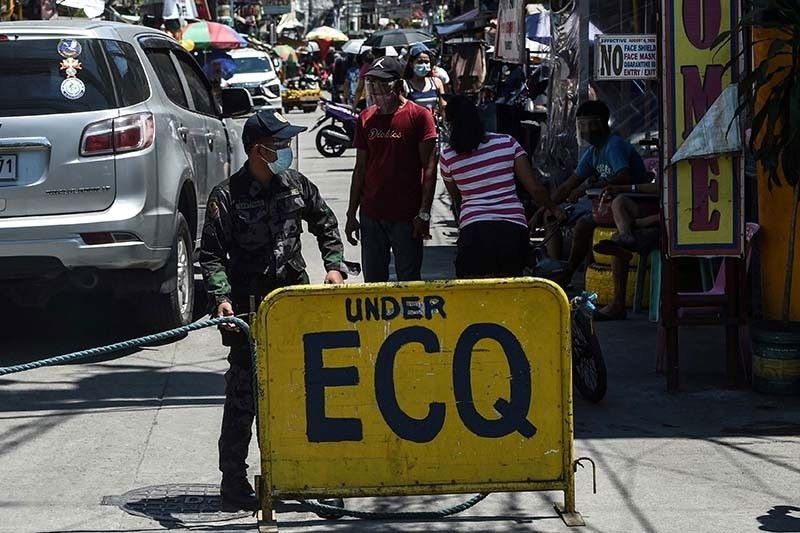ECQ working, but 1 week extension needed – experts

MANILA, Philippines — Experts are pushing for a one-week extension of the enhanced community quarantine (ECQ) in Metro Manila and nearby provinces in order to maintain the downtrend in the surge of new COVID-19 cases.
The OCTA Research Group made the recommendation as Malacañang cancelled yesterday its scheduled announcement on whether to end or extend the ECQ for the National Capital Region (NCR) Plus bubble. Aside from NCR or Metro Manila, the provinces under ECQ, which expires today, are Cavite, Laguna, Rizal and Bulacan.
“President Duterte is weighing the pros and cons before making his final decision regarding the quarantine classification of the National Capital Region Plus area,” presidential spokesman Harry Roque said yesterday.
In deferring his announcement, Roque said Duterte also wanted to review reports on health care utilization rate or the capacity of hospitals and medical facilities handling COVID-19 cases.
“The Chief Executive would like to review and check pertinent information such as the Health Care Utilization Rate (HCUR) of the aforesaid area,” Roque said.
In its latest monitoring report released yesterday, the group confirmed that the two-week ECQ implemented in the NCR Plus has lowered the reproduction number of new cases, or the number of persons that a positive individual can infect.
From 1.88 the week before the ECQ was imposed, the reproduction number in Metro Manila is now at 1.23.
And, for the first time in three weeks, Metro Manila has finally experienced a negative growth in new daily cases, recording an average of 4,787 new cases per day from April 3 to 9, down nine percent from the preceding week.
“Be that as it may, the reproduction number for the NCR remains above 1, meaning that significant viral transmissions continue,” read the report.
“Moreover, the average daily number of new cases of COVID-19 in the NCR+ is still very high at 5,000 a day. A continuing concern is that hospital capacity in the region and in the bubble remains at critical capacity, with some hospitals already maxed out,” OCTA added.
Extending the ECQ for another week will be able to further slow down the surge, decongest the hospitals and relieve the pressure on healthcare workers, the group said.
“Opening up the NCR+ prematurely would be a significant risk as it could accelerate the surge again,” it said. “However, if ECQ extension cannot be considered for socioeconomic reasons, we are suggesting a minimum of two weeks of MECQ (modified MECQ).”
Citing data from the Department of Health, OCTA said most cities in Metro Manila have shown decreasing number of new infections over the past week.
“This is very encouraging, although it is too early to say if these local government units are now starting on a downward trend, especially given that testing was 20 percent lower during the Holy Week,” read the report.
“Unfortunately, new COVID-19 cases in the NCR will remain high, between 4,000 and 6,000 per day, while the reproduction number remains at 1 or higher,” it added.
OCTA said the government should continue its efforts to expand testing, tracing and isolation to accelerate the exit of NCR Plus from ECQ.
“Government should also work together with the local government units and the private sector to accelerate the vaccination of our citizens in the NCR bubble. We need more vaccination sites and more personnel and volunteers in the vaccination centers to speed up the process,” it said.
“In particular, we need to expand the number of vaccination sites in the NCR to accommodate more individuals and reduce the possibility of super-spreader events due to crowding in vaccination centers. We suggest considering large and open public and private structures, such as university gyms and even malls, apart from public schools, as alternative vaccination sites,” it added.
OCTA said there is also a need to recruit more doctors and nurses to augment the existing teams doing vaccination in NCR Plus.
Unlike Metro Manila that recorded a decrease in new cases, some regions have reported a spike in cases in the past week, including Calabarzon with an average of 1,861 new cases per day (up five percent from the previous week), Central Luzon with 978 (up one percent), Cagayan Valley with 606 (up 31 percent), Cordillera Administrative Region with 429 (up 79 percent) and Ilocos Region with 272 (up 67 percent).
“NCR, Calabarzon and Central Luzon account for nearly 80 percent of the new COVID-19 cases, with another 10 percent from CAR and Region II. High hospital utilization rates were observed in the top five regions,” read the report.
Metro Manila Council (MMC) chairman and Parañaque City Mayor Edwin Olivarez said he is in favor of reopening Metro Manila’s economy on condition that health protocols are strictly followed.
“The reopening of the economy is really needed by the people but we just don’t have to sacrifice health protocols,” he said in an interview with “The Chiefs” on Cignal TV’s One News/TV5 Friday night.
Olivarez made the statement as the country tallied its highest COVID-19 daily death toll at 401 on Friday when at least 12,000 new cases of infections were recorded.
“There should be a balance between safeguarding health and the economy. There is no substitute to heath,” he said.
To complement the reopening of businesses, Olivarez said public safety measures should remain in place such as banning mass gatherings as well as strict enforcement of wearing of face masks and face shields in public places.
Olivarez also said the referral system at hospitals in the region should be more organized to avoid long queues of COVID-19 patients waiting for admission.
The local chief executive said patients with mild or no symptoms should be placed in isolation facilities so that hospitals are reserved for severe cases.
He said in Parañaque, there are isolation units in every barangay for asymptomatic patients and those with symptoms are brought to hospitals for assessment.
Parañaque has eight private medical facilities and two public hospitals, according to Olvarez.
He also said some 10 to 15 percent of barangay health workers have opted to hold off getting vaccinated for “mixed reasons.”
The city government can conduct 7,000 vaccinations a day if they have a full supply of COVID-19 jabs.
Also last Friday on “The Chiefs,” Bulacan Gov. Daniel Fernando said the province – especially its health care system – is ready for any easing of quarantine restrictions tomorrow.
Fernando said COVID-19 cases in Bulacan went down by 10 to 30 percent during the two-week ECQ, but did not elaborate.
He said the ban on public gatherings and liquor will remain in force.
He also said regular street patrols will continue even during daytime and not only during curfew as COVID-19 “does not only work in night shift.” – Christina Mendez, Emmanuel Tupas
- Latest
- Trending



























